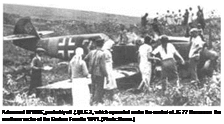With the Last Forces toward Rostov
|
F |
ollowing the annihilation of the Soviet Eighteenth Army north of the Sea of Azov during the first week of October, the Soviet Southern Front retained only weak forces to counter the offensive by the German First Panzer Army toward the city of Rostov, the gateway to the Caucasus. The Soviets attempted to build a new defense line along the Mius River, about fifty miles west of Rostov. Worsened weather conditions, which created enormous logistical problems for the Germans, and the diversion of Luftwaffe units to the Battle of the Crimea were what mainly saved the Soviet defenses in this sector from a total breakdown.
The battle in the air above the road to Rostov was fought between the last poor remnants of the once – powerful Fliegerkorps V and VVS-Southern Front. Heavy attrition during a sustained campaign had worn down the units in Fliegerkorps V to an average of six to nine serviceable aircraft in each Gruppe. On top of this, shortages of fuel and spare parts particularly affected the twin – engine bomber units, KG 54 and KG 55.
With most air force replacements bound for the Moscow sector, four months of accumulated losses had left VVS-Southern Front with no more than a mere 130 serviceable aircraft by mid-October. But at least the Soviets were spared the supply problems of their adversaries, because their aviation regiments operated in the immediate vicinity of some of their nation’s main supply bases. Hence the Soviet air commanders could launch every available plane in five, six, or even more sorties over the front lines each day. Through this permanent maximum effort, considerable pressure from the air was dealt to the German ground troops moving very slowly ahead in the deep mud.
Podpolkovnik Leonid Goncharov’s 131 IAP, rated
 as a crack unit, was assigned to fend off the threat from the German Jagdgruppen in this area, I.(J)/LG 2 and 1I./JG 77. During the first three months of the war, 131 IAP had taken part in approximately five hundred aerial combats, during which sixty-three enemy aircraft were claimed.’ This regiment included several outstanding fighter pilots: The deputy commander, Kapitan Viktor Davidkov, counted six personal and two shared victories by September 1941; and Starshiy Politruk Moisey Tokarev claimed five Bf 109s and two Ju 88s shot down during only eight air combats before the end of 1941. Another highly rated pilot with this unit was Mladshiy Leytenant Dmitriy Nazarenko, a veteran of the Winter War.
as a crack unit, was assigned to fend off the threat from the German Jagdgruppen in this area, I.(J)/LG 2 and 1I./JG 77. During the first three months of the war, 131 IAP had taken part in approximately five hundred aerial combats, during which sixty-three enemy aircraft were claimed.’ This regiment included several outstanding fighter pilots: The deputy commander, Kapitan Viktor Davidkov, counted six personal and two shared victories by September 1941; and Starshiy Politruk Moisey Tokarev claimed five Bf 109s and two Ju 88s shot down during only eight air combats before the end of 1941. Another highly rated pilot with this unit was Mladshiy Leytenant Dmitriy Nazarenko, a veteran of the Winter War.
On October 22, 1941, the l-16s of 131 IAP escorted a formation of SB bombers against a German airfield. While attempting to intercept the SBs, I.(J)/LG 2 lost two Bf 109 shot down—both falling prey to Mladshiy Leytenant Nazarenko. 131 IAP would file claims for twenty-one enemy aircraft destroyed in the air on October 22, including four by Nazarenko. There are, however, no according German loss reports that substantiate such high claims.
Confronted with the experts of Hauptmann Anton Mader’s 1I./JG 77, WS-Southern Front paid dearly for its “maximum effort.” Eleven Soviet aircraft were shot down by 1I./JG 77 on October 23. On October 27, Podpolkovnik Goncharov dispatched his last I-16s against
the German fighter base at Taganrog, on 1 the northern shore of the Sea of Azov, I but they only succeeded in putting one 1 Bf 109 out of commission,
Of seventy-nine serviceable fighters J available to VVS-Southern Front on 1 October 1, forty-three were registered as 1 “totally lost” by November l. s II./JG 77 I claimed thirty-seven victories for only one I loss in air combat between October 27 1 and 31. Podpolkovnik Goncharov was 1 killed in action on October 31, possibly 1 as the thirty-second victory credited to I Oberlcutnant Heinrich Setz of 4./JG 77. 1
Once it crossed the Mius River, the First Panzer Army 1 opened its final offensive against Rostov on November I 5. Luftwaffe raids enabled the Germans to break through j on the left flank. Next, the bombers of KG 54 and KG 1 55 were sent into action against both the retreating troops I of the Southern Front and the massive Soviet reinforce – 1 ments moving on the rail lines connecting Rostov with 1 the Caucasus. In the course of the latter attacks, the j bomber crews reported the destruction of 79 trains with 1 another 148 damaged by direct hits.9
Once again, it was “General Mud” who saved the ] Soviets. Already on November 6, new rain showers made j the roads impassable, and the attack came to a complete I standstill. A few days later, the temperature dropped 1 below the freezing point, creating severe difficulties in 1 starting the engines of tanks and aircraft in primitive I field conditions.
At this point the staff of Fliegerkorps V was shifted J from the Eastern Front to Brussels, with the intention I of organizing a mine-laying air corps to be used against ] Britain. All elements of KG 54 and KG 55 were also j pulled back.
The Soviets made use of the lull created by wore – j ened weather conditions to rebuild their battered forces. ] In mid-November VVS-Southern Front mustered 119 I bombers, 72 fighters, and 13 ground-attack aircraft, the j highest figures in three months.










